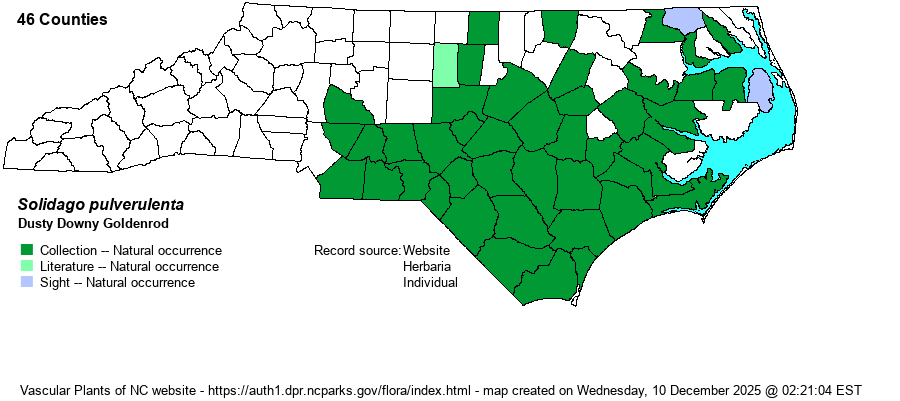| Section 6 » Family Asteraceae |
Show/Hide Synonym
| taxonName | relationship | relatedTaxonName | relatedTaxonRefText | relComments |
|---|
|
| Solidago pulverulenta | = | Solidago puberula var. pulverulenta | Gleason and Cronquist (1991) | | | Solidago pulverulenta | = | Solidago puberula var. pulverulenta | Fernald (1950) | | | Solidago pulverulenta | = | Solidago puberula var. pulverulenta | Gleason (1952) | | | Solidago pulverulenta | = | Solidago puberula var. pulverulenta | Kartesz (1999) | | | Solidago pulverulenta | = | Solidago puberula var. pulverulenta | Radford, Ahles, and Bell (1968) | | | Solidago pulverulenta | = | Solidago puberula var. pulverulenta | Vascular Flora of the Southeastern States (Cronquist 1980, Isely 1990) | | | Solidago pulverulenta | = | Solidago puberula var. pulverulenta | Flora of Virginia | | | Solidago pulverulenta | = | Solidago puberula var. pulverulenta | Wunderlin & Hansen Flora of Florida (3) | | | Solidago pulverulenta | = | Solidago puberula ssp. pulverulenta | Flora of North America (1993b, 1997, 2000, 2002a, 2002b, 2003a, 2004b, 2005, 2006a, 2006b, 2006c, 2007a, 2009, 2010) | | | Source: Weakley's Flora |
|
| Author | Nuttall | |
| Distribution | Coastal Plain, Sandhills, and lower to middle Piedmont, west only to Person, Rowan, and Cabarrus counties.
Mostly Coastal Plain, southeastern VA to northern FL and LA. | |
| Abundance | Frequent to common in the southern half of the Coastal Plain, including the Sandhills. Uncommon in the northern half of the Coastal Plain; mostly rare in the eastern and southeastern Piedmont, more numerous in the southern counties. | |
| Habitat | Dry to mesic or moist soils of pine-deciduous woodlands and forest openings, clearings, clearcuts, roadsides. Occasionally in Longleaf Pine-Wiregrass savannas and flatwoods, but mostly where disturbed. Generally found in acidic soils near or under pines, often where the ground is damp or somewhat so, but it is not found in overly wet sites. | |
| Phenology | Flowering and fruiting late August-October. | |
| Identification | Dusty Downy Goldenrod grows 1.5-3 feet tall, the stems and leaves covered with tiny whitish hairs that usually give the plant a grayish-green tone. The inflorescence is elliptical to narrowly tubular in outline and tapered to both ends. In the field it resembles S. erecta, but that plant is smooth (glabrous). S. speciosa is usually much taller (3-6 feet) and its involucral bracts have rounded tips (vs. acute). Its closest ally is S. puberula, which differs in fewer leaves per stem (20-60 vs. 50-100+) and longer leaves (4-5 cm vs. less than 4 cm in S. pulverulenta). Also, S. puberula is a montane species in NC, though it has been recorded once in Cabarrus County, in the central Piedmont. | |
| Taxonomic Comments | Solidago pulverulenta has been treated as a variety or a subspecies of S. puberula by some authors. Most authors still do not consider it as a valid species, such as NatureServe, but Weakley (2018) does. Semple et al. (2020) also treat it as a full species.
| |
| Other Common Name(s) | There seem to be no common names online, as these references have the taxon still grouped under S. puberula, with the Downy Goldenrod name. That common name is "reserved" for S. puberula. As "pulverulenta" means "dusty", a common name is here listed as Dusty Downy Goldenrod. This makes "Downy Goldenrod" a nested name, and thus S. puberula should have a modifier, but none is mentioned. However, naming S. pulverulenta simply as Dusty Goldenrod is not quite appropriate. | |
| State Rank | S4? [S5] | |
| Global Rank | G5T4T5 [G4G5] | |
| State Status | | |
| US Status | | |
| USACE-agcp | | |
| USACE-emp | | |

